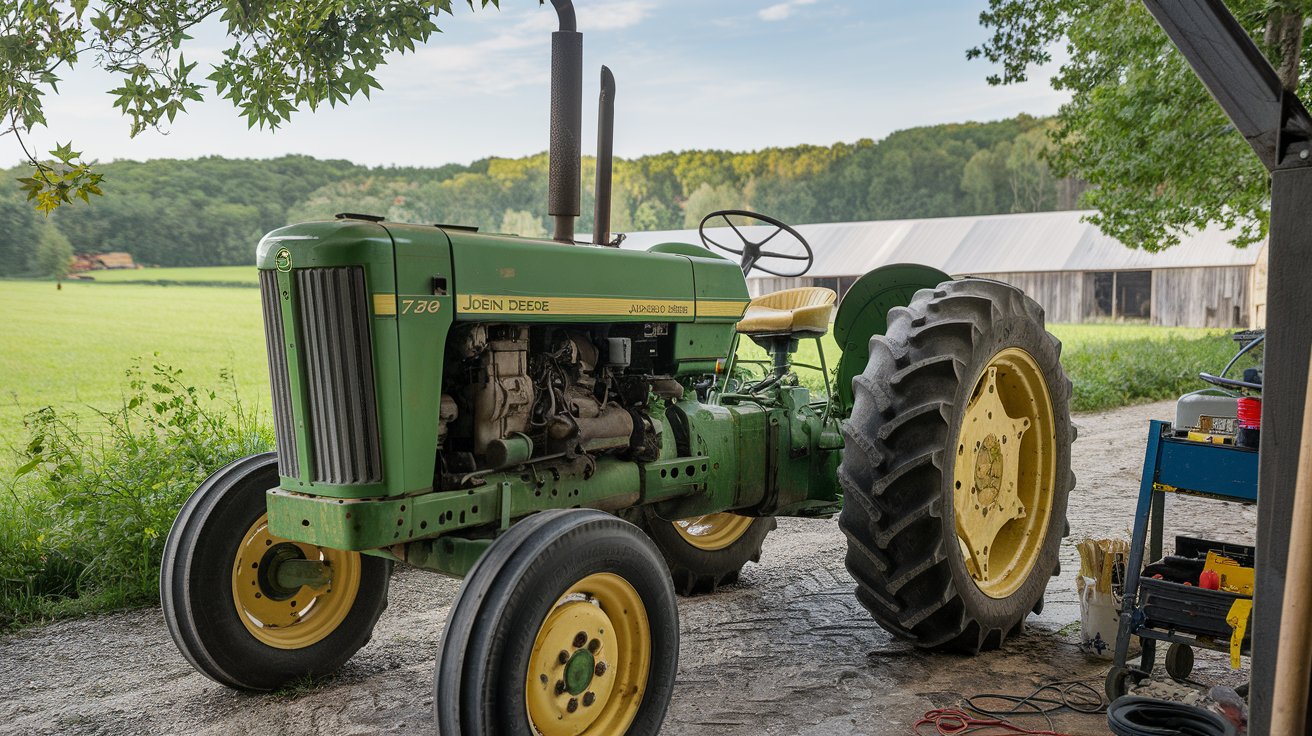The John Deere 790 is a reliable tractor, but it’s not immune to common mechanical issues. Problems like front-end weakness, hydraulic leaks, and transmission concerns can affect its performance. Other challenges, such as PTO clutch malfunctions, brake wear, and fuel filter clogs, may arise with regular use. Understanding these issues and their solutions is crucial for maintaining your tractor’s efficiency and extending its lifespan. Proactive maintenance and following manufacturer guidelines can significantly reduce downtime.
Curious to know the full list of potential problems and expert solutions? Keep reading to discover how to tackle these challenges and keep your John Deere 790 running smoothly.
In this guide, we’ll explore the top 10 John Deere 790 problems and practical solutions to address them.
1. Front-End Weakness
One of the most common complaints among John Deere 790 owners is the front-end weakness. This issue primarily affects the structural integrity when handling heavy loads or attachments like loaders.
Symptoms:
- Bending or cracking in the front axle housing.
- Difficulty steering when under load.
Causes:
- Overloading the front-end beyond its design capacity.
- Improper weight distribution when using front-end attachments.
Solutions:
- Use counterweights to balance the load.
- Avoid exceeding the manufacturer’s recommended weight limits.
- Inspect the axle housing regularly for signs of stress or wear.
2. Hydraulic Issues
Hydraulics play a vital role in the operation of the 790, particularly for powering implements and loaders. Hydraulic problems can manifest as leaks, slow operation, or complete system failure.
Symptoms:
- Slow or unresponsive hydraulic arms.
- Oil leaks around hydraulic hoses or seals.
- Whining noises from the hydraulic pump.
Causes:
- Worn-out seals or hoses.
- Contaminated hydraulic fluid.
- Low hydraulic fluid levels.
Solutions:
- Replace damaged seals or hoses promptly.
- Regularly check and refill hydraulic fluid.
- Change the hydraulic filter according to the service manual.
3. Battery Connection Problems
Electrical issues, particularly those related to the battery, can cause unexpected downtimes for the John Deere 790.
Symptoms:
- Difficulty starting the engine.
- Flickering or dim dashboard lights.
Causes:
- Corroded battery terminals.
- Loose or frayed cables.
- Aging battery.
Solutions:
- Clean the battery terminals using a wire brush and baking soda solution.
- Tighten all cable connections.
- Replace the battery if it’s more than 3-5 years old.
4. Transmission Concerns
The transmission system on the John Deere 790, though generally reliable, can present issues over time, especially with wear and tear.
Symptoms:
- Difficulty shifting gears.
- Grinding noises during operation.
Causes:
- Low transmission oil levels.
- Worn-out clutch components.
Solutions:
- Check and refill transmission oil as needed.
- Adjust the clutch linkage according to the service manual.
- Replace worn clutch parts if necessary.
5. PTO Clutch Issues
The Power Take-Off (PTO) system is essential for powering implements like mowers and tillers. PTO clutch issues can significantly disrupt your workflow.
Symptoms:
- PTO fails to engage.
- Slipping or reduced power transfer.
Causes:
- Worn-out PTO clutch plates.
- Misalignment in the PTO shaft.
Solutions:
- Replace the PTO clutch plates.
- Ensure the PTO shaft is properly aligned and lubricated.
6. Front-End Loader Problems
While the John Deere 790 works well with loaders, some users report problems such as difficulty in attachment or loader instability.
Symptoms:
- Loader doesn’t stay in position.
- Struggles to lift heavy loads.
Causes:
- Loose mounting brackets.
- Inadequate hydraulic pressure.
Solutions:
- Tighten all loader mounting hardware.
- Check the hydraulic system for leaks or low pressure.
- Use a loader size compatible with the 790’s specifications.
7. Bearing Replacement
Over time, bearings in the John Deere 790’s various components may wear out, leading to operational inefficiencies or breakdowns.
Symptoms:
- Unusual noises during operation.
- Excessive vibration.
Causes:
- Natural wear and tear.
- Insufficient lubrication.
Solutions:
- Inspect bearings during routine maintenance.
- Replace worn or damaged bearings.
- Apply grease regularly to maintain lubrication.
8. Front Axle Challenges
The front axle of the John Deere 790 can be a point of concern, especially for users operating in rugged or uneven terrains.
Symptoms:
- Cracks or fractures in the axle.
- Difficulty steering.
Causes:
- Excessive load on the front wheels.
- Impact damage from rough terrain.
Solutions:
- Avoid overloading the tractor.
- Conduct regular inspections of the axle for damage.
- Reinforce the axle if cracks are detected early.
9. Brake Problems
Reliable brakes are crucial for safe operation, but issues with the brake system can arise, especially with older models.
Symptoms:
- Reduced braking power.
- Squealing or grinding noises when applying brakes.
Causes:
- Worn-out brake pads.
- Air trapped in the brake lines.
Solutions:
- Replace the brake pads if they’re worn.
- Bleed the brake lines to remove air.
- Check the brake fluid level regularly.
10. Fuel Filter and Front Wheel Issues
A clogged fuel filter and front wheel problems can also cause significant headaches for John Deere 790 owners.
Fuel Filter Problems:
Symptoms:
- Engine stalling or loss of power.
Causes:
- Dirt or debris in the fuel system.
Solutions:
- Replace the fuel filter every 200 hours of operation or as recommended.
Front Wheel Issues:
Symptoms:
- Uneven tire wear.
- Difficulty steering.
Causes:
- Misaligned front wheels.
- Faulty wheel bearings.
Solutions:
- Realign the wheels.
- Replace worn-out bearings.
Additional Problems to Address
11. Overheating Issues
- Symptoms:
- Engine overheating during prolonged use.
- Warning lights on the dashboard.
- Causes:
- Clogged radiator.
- Low coolant levels.
- Solutions:
- Clean the radiator fins.
- Refill or replace coolant regularly.
12. Steering Difficulties
- Symptoms:
- Heavy or unresponsive steering.
- Jerky movements while turning.
- Causes:
- Low steering fluid.
- Worn-out steering linkage.
- Solutions:
- Check and top up steering fluid.
- Replace worn-out linkage components.
13. Electrical System Failures
- Symptoms:
- Malfunctioning lights or controls.
- Frequent blown fuses.
- Causes:
- Faulty wiring or connectors.
- Water ingress into electrical components.
- Solutions:
- Inspect and repair damaged wires.
- Use waterproof connectors.
14. Exhaust Smoke Issues
- Symptoms:
- Excessive black or white smoke from the exhaust.
- Causes:
- Dirty air filter or fuel injectors.
- Poor-quality fuel.
- Solutions:
- Clean or replace the air filter.
- Use high-quality diesel fuel.
15. Seat Comfort and Suspension
- Symptoms:
- Discomfort during prolonged operation.
- Uneven suspension.
- Solutions:
- Upgrade to a cushioned seat with better suspension.
- Regularly inspect suspension components.
Preventive Maintenance Tips
- Scheduled Maintenance: Follow the manufacturer’s maintenance schedule to avoid major breakdowns.
- Lubrication: Regularly grease all moving parts, including joints and bearings, to prevent wear and tear.
- Storage: Store the tractor in a dry and covered space to prevent rust and weather-related issues.
- Cleaning: Wash the tractor after use to remove dirt, mud, and debris that can cause damage over time.
- Routine Inspections: Check for leaks, cracks, or abnormal noises before and after use.
Tips for New Owners
- Read the Manual: Familiarize yourself with the user manual to understand operational guidelines.
- Join Communities: Engage in forums and groups for John Deere owners to exchange tips and experiences.
- Keep Spare Parts: Stock essential parts like filters, seals, and fuses for quick fixes.
Comparison with Similar Models
How does the John Deere 790 compare to its peers?
- Advantages: Compact design, reliability, and ease of operation.
- Drawbacks: Limited power for larger tasks, prone to certain mechanical issues.
- Alternatives: Models like the John Deere 855 or Kubota B-series for slightly more power or modern features.
DIY Maintenance Checklist
- Daily Checks:
- Inspect tire pressure and fuel levels.
- Check for visible leaks or loose components.
- Weekly Checks:
- Test battery voltage.
- Inspect belts and hoses for wear.
- Monthly Checks:
- Change engine oil if due.
- Replace filters as needed.
- Seasonal Maintenance:
- Inspect the cooling system before summer.
- Test and prepare the tractor for winter storage.
Frequently Asked Questions (FAQs)
1. What are the most common issues with the John Deere 790?
The most common issues include front-end weakness, hydraulic problems, battery connection issues, transmission concerns, and PTO clutch malfunctions.
2. How can I prevent hydraulic issues in my John Deere 790?
Regularly check hydraulic fluid levels, replace damaged seals or hoses, and change the hydraulic filter as per the service manual’s recommendations.
3. What causes front-end weakness in the John Deere 790?
Front-end weakness is often caused by overloading and improper weight distribution when using front-end attachments.
4. How often should I replace the fuel filter on a John Deere 790?
The fuel filter should be replaced every 200 hours of operation or as recommended by the manufacturer.
5. Why is my John Deere 790’s PTO not engaging?
This could be due to worn-out PTO clutch plates or misalignment in the PTO shaft. Inspect and replace these components as needed.
6. What should I do if the front axle on my John Deere 790 shows signs of damage?
Stop using the tractor immediately and inspect the axle for cracks or fractures. Reinforce or replace the axle to prevent further damage.
7. How can I fix battery connection issues?
Clean the battery terminals, tighten the cables, and replace the battery if it is old or underperforming.
8. Why is my John Deere 790 making grinding noises during operation?
Grinding noises may indicate worn-out bearings, insufficient lubrication, or transmission issues. Inspect these areas and perform maintenance as needed.
9. How do I address brake problems on my John Deere 790?
Replace worn-out brake pads, bleed the brake lines to remove air, and check brake fluid levels regularly.
10. Can I use any front-end loader with my John Deere 790?
No, you should use a front-end loader that is compatible with the John Deere 790’s specifications to ensure safety and optimal performance.
Conclusion
Understanding these John Deere 790 problems and their solutions can help you maintain your tractor’s performance and extend its lifespan. Regular maintenance and adhering to the manufacturer’s guidelines are key to avoiding many of these issues. Whether it’s a front-end weakness or a simple battery connection problem, being proactive will save you time and effort in the long run.
If you’ve encountered any other issues with your John Deere 790 or have tips for maintenance, feel free to share them in the comments below!

